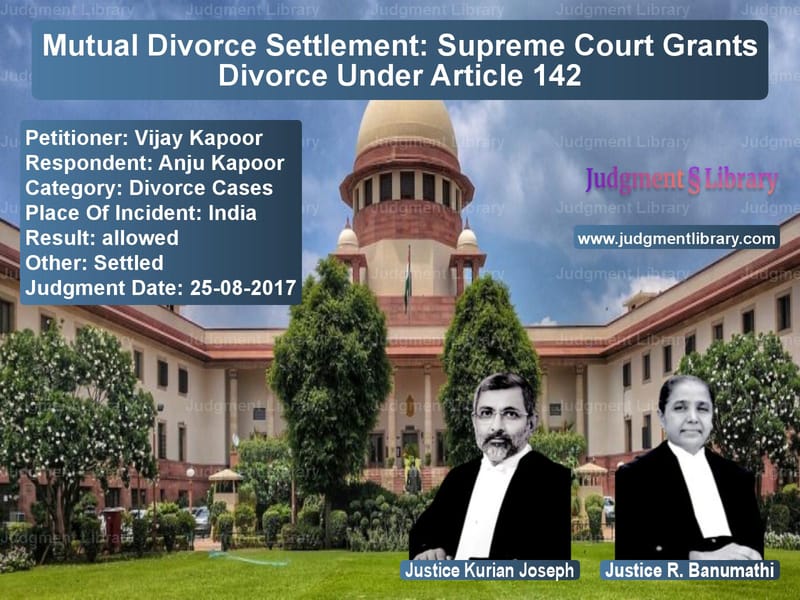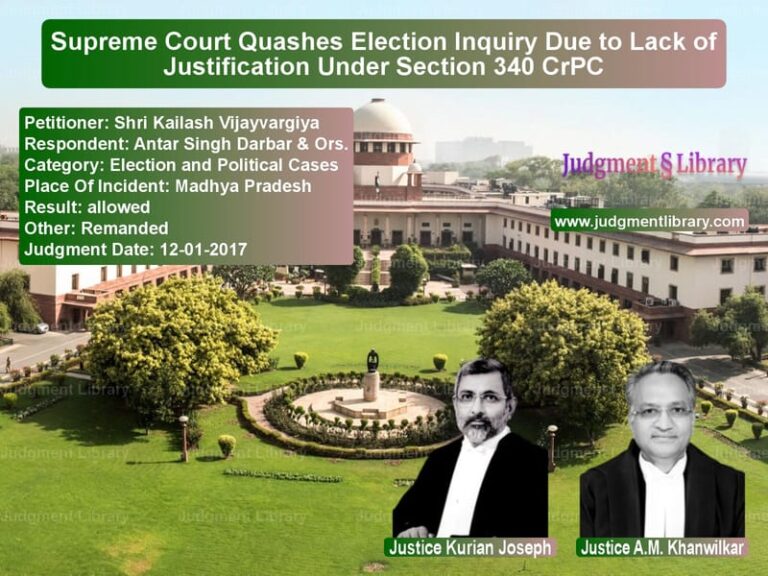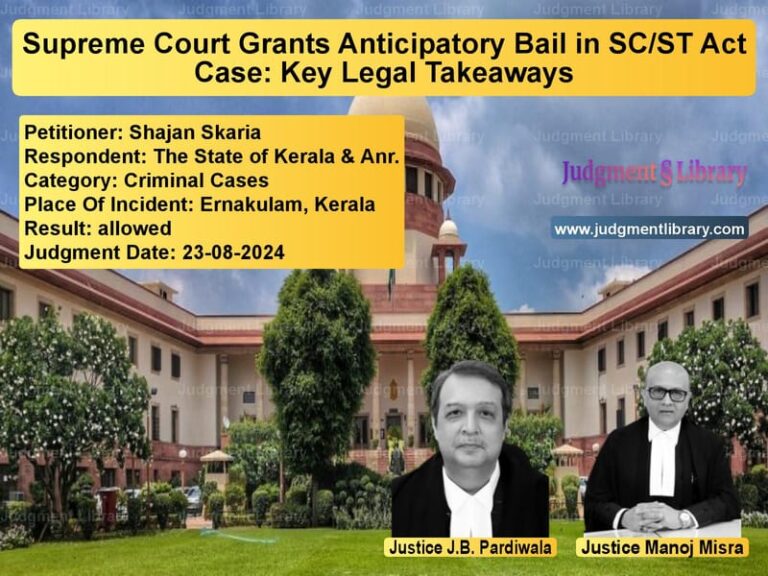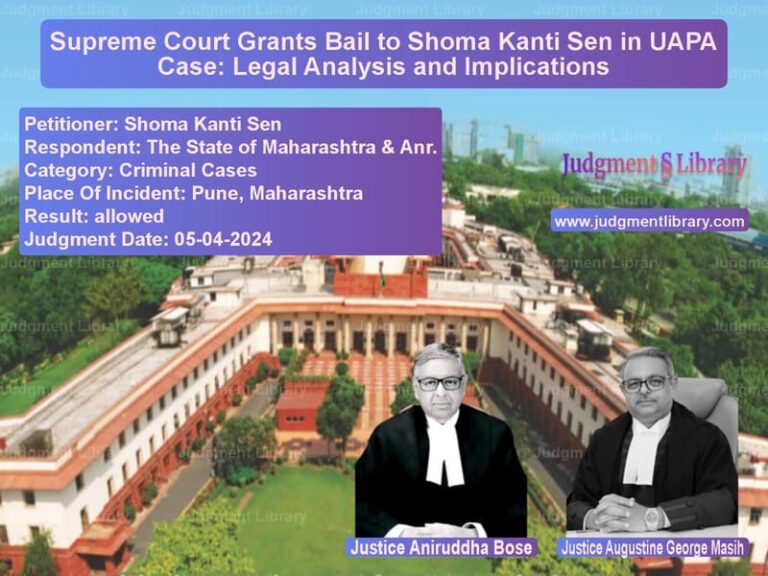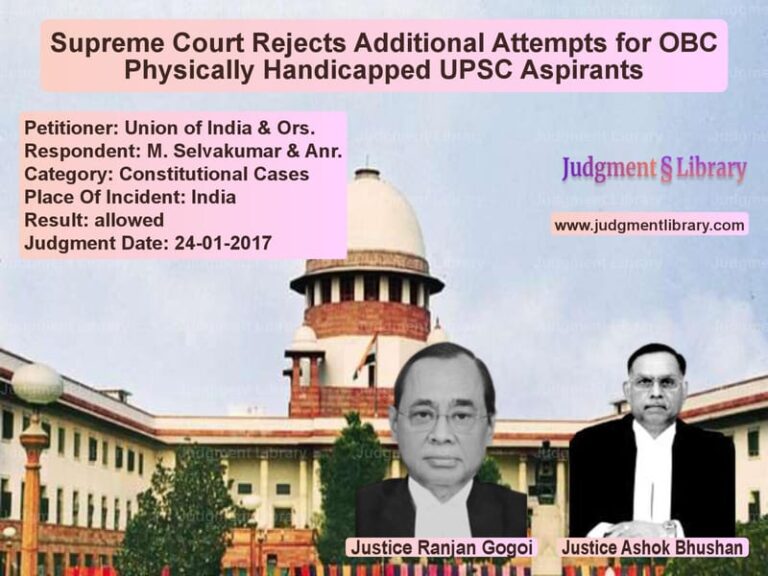Mutual Divorce Settlement: Supreme Court Grants Divorce Under Article 142
The case of Vijay Kapoor vs. Anju Kapoor is a significant Supreme Court ruling involving a prolonged matrimonial dispute that ultimately resulted in a divorce by mutual consent. The Court exercised its powers under Article 142 of the Constitution of India to dissolve the marriage between the parties, ensuring an amicable settlement and safeguarding the interests of their children.
The judgment is an essential precedent in matrimonial cases where prolonged litigation causes distress to both parties, and judicial intervention helps bring about a peaceful resolution. The case highlights the role of the Supreme Court in facilitating out-of-court settlements and ensuring justice beyond technical legal considerations.
Background of the Case
The appellant, Vijay Kapoor, and the respondent, Anju Kapoor, had been involved in a long-standing marital dispute for over 12 years. Several cases were filed in lower courts concerning various aspects of their separation, including property disputes, custody issues, and financial settlements.
The parties had approached the Supreme Court in March 2016, seeking final resolution. During the proceedings, the appellant’s sister, Ms. Ritu Batta, played a crucial role in facilitating a mutual settlement between the parties. The parties formally agreed to a settlement on August 25, 2017, and the same was recorded before the Court.
Key Legal Issues
- Whether the Supreme Court could grant a divorce under Article 142 despite pending proceedings in lower courts.
- Whether the terms of the mutual settlement, including property distribution and child welfare, were legally enforceable.
- Whether the dissolution of marriage by mutual consent required additional compliance under Section 13B of the Hindu Marriage Act.
Arguments by the Petitioner (Vijay Kapoor)
The petitioner, through his counsel, submitted that:
- The parties had been living separately for over a decade, making reconciliation impossible.
- All pending disputes had been settled amicably through a memorandum of settlement.
- The mutual divorce should be granted immediately under Article 142 to avoid further litigation.
- The family settlement should be given legal recognition to ensure the welfare of their children.
Arguments by the Respondent (Anju Kapoor)
The respondent, represented by legal counsel, contended that:
- The marriage had irretrievably broken down, and mutual divorce was the only viable solution.
- The terms of the settlement, including the property transfer and child support, should be enforced by the Court.
- The divorce should not affect the right of their children to parental support and inheritance.
- The case should be concluded to prevent further legal and emotional distress.
Supreme Court’s Judgment
The Supreme Court, in a judgment delivered by Justice Kurian Joseph and Justice R. Banumathi, granted the divorce under Article 142 of the Constitution.
1. Exercise of Article 142 Powers
The Court noted that given the long separation and prolonged litigation, it was in the best interest of both parties to dissolve the marriage immediately. The judgment stated:
“Having regard to the prolonged litigation between the parties and long separation spanning over a period of around 12 years, we are of the view it is in the interest of the respective families to give a quietus to the agony.”
2. Recognition of Mutual Settlement
The Court took on record the Memo of Settlement dated August 25, 2017 and made it part of the judgment. The settlement terms included property division and child welfare arrangements, ensuring that both parties fulfilled their agreed obligations.
3. Transfer of Property
The Court addressed the property dispute, directing that the appellant’s sister, Ms. Ritu Batta, who had received a property transfer from the appellant and his parents, must transfer it to the respondent and their children:
“Ms. Ritu Batta, the sister of the appellant, submits that the property is actually to be settled in favor of the respondent, Anju Kapoor, and the two children, namely, Vedant Kapoor and Akshita Kapoor.”
4. Family Welfare Considerations
The Court emphasized that despite the divorce, both parties should ensure their children’s well-being:
“The parties have undertaken before this Court that their separation and divorce shall not stand in the way of cooperating with the marriage and other related functions of the children born to them.”
5. Legal Registration of Property Settlement
The Court facilitated the property transfer process by directing the Registrar to levy only the necessary fees for a family settlement:
“We, however, make it clear that in view of the transaction being essentially a family settlement, the Registrar concerned for registering the document shall levy only the required fee for a deed of family settlement.”
6. Closure of Pending Legal Matters
Since all disputes were settled amicably, the Court directed the following:
- The mobile phone of Vijay Kapoor, which was earlier deposited in the High Court, should be returned to him.
- The attachment of properties related to the case should be released.
- The appellant should return any records belonging to the children.
Key Takeaways from the Judgment
- Supreme Court’s Powers Under Article 142: The ruling demonstrates the Court’s ability to grant immediate divorce in cases where prolonged litigation has caused suffering to both parties.
- Recognition of Out-of-Court Settlements: The Court acknowledged and enforced the terms of the mutual settlement, emphasizing the importance of amicable resolutions.
- Child Welfare Considerations: The Court ensured that the interests of the children were protected, even after the divorce.
- Family Property Settlements: The judgment clarifies the legal treatment of family settlements in divorce cases, particularly when third parties hold property in trust for children.
Impact of the Judgment
This ruling is a significant precedent for matrimonial disputes involving long separations and extensive litigation. It provides a model for resolving cases through mutual consent and judicial intervention, reducing the emotional and financial burden on both parties.
The decision also highlights the role of family members in facilitating settlements and demonstrates the Court’s commitment to upholding justice while maintaining compassion for the affected individuals.
Conclusion
The Supreme Court’s judgment in Vijay Kapoor vs. Anju Kapoor sets an important precedent in matrimonial law by granting a mutual divorce under Article 142. The ruling ensures fairness, acknowledges family settlements, and prioritizes the welfare of children.
By finalizing the divorce through a legally recognized settlement, the Court provided a dignified resolution to a prolonged legal battle, demonstrating that the judiciary can facilitate justice beyond strict legal formalities.
Don’t miss out on the full details! Download the complete judgment in PDF format below and gain valuable insights instantly!
Download Judgment: Vijay Kapoor vs Anju Kapoor Supreme Court of India Judgment Dated 25-08-2017.pdf
Direct Downlaod Judgment: Direct downlaod this Judgment
See all petitions in Mutual Consent Divorce
See all petitions in Alimony and Maintenance
See all petitions in Child Custody
See all petitions in Judgment by Kurian Joseph
See all petitions in Judgment by R. Banumathi
See all petitions in allowed
See all petitions in settled
See all petitions in supreme court of India judgments August 2017
See all petitions in 2017 judgments
See all posts in Divorce Cases Category
See all allowed petitions in Divorce Cases Category
See all Dismissed petitions in Divorce Cases Category
See all partially allowed petitions in Divorce Cases Category

